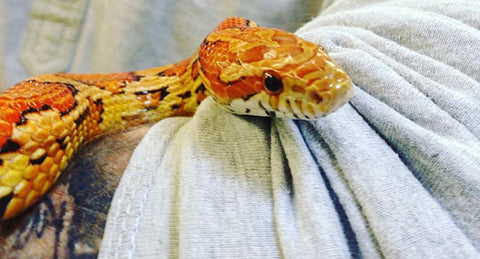Your Reptilian Companion Waits For: Snake for Sale Options Revealed
Wiki Article
How to Develop the Perfect Habitat for Your Animal Snake
Developing the optimal environment for your pet dog serpent is crucial to ensuring its health and health. From selecting the appropriate unit to supplying the suitable temperature level and moisture degrees, there are numerous factors to take into consideration when establishing an environment that resembles your serpent's native environment. By recognizing the particular needs of your serpent types and carrying out the necessary elements in its habitat, you can develop a room where your animal can prosper. Allow's check out the essential components that go right into making the excellent home for your slithery buddy.Choosing the Right Room
The unit serves as the serpent's main habitat, affecting its overall well-being and habits. A general regulation of thumb is to provide a habitat that is at least as long as the serpent's size and large enough for it to stretch out easily.
Timber and PVC rooms provide exceptional insulation, which is crucial for managing temperature level and moisture degrees within the environment. Eventually, the enclosure needs to simulate the serpent's all-natural habitat as very closely as feasible to guarantee its wellness and happiness.
Establishing Temperature Level and Moisture Levels
In order to provide a helpful living atmosphere for your pet dog snake within the picked enclosure, focus to maintaining ideal temperature level and humidity levels is extremely important. Snakes are ectothermic animals, implying they depend on external resources to control their body temperature level. For the majority of snake types, the excellent temperature level arrays in between 75-85 ° F(24-29 ° C) on the colder end and 85-90 ° F(29-32 ° C) on the warmer end. To attain this gradient, you can use hot pad, warmth lamps, or ceramic heating systems. It is vital to place thermometers at both ends of the enclosure to check the temperature consistently.Humidity degrees are equally vital for your serpent's wellness and shedding process. The suitable humidity level varies depending upon the snake varieties, with the majority of calling for degrees between 40-60%. Offering a big water meal, misting the enclosure, or utilizing a reptile humidifier can assist preserve ample humidity. However, guarantee appropriate ventilation to protect against excess dampness, which can cause breathing problems. By vigilantly readjusting and monitoring temperature level and humidity degrees, you can create a comfortable and safe habitat for your cherished animal snake.
Providing Adequate Concealing Areas
Making sure the schedule of ideal hiding places is vital for developing a stress-free environment for your pet snake. To resemble their natural habitat, provide at least 2 hiding areas in your snake's enclosure-- one on the warmer side and one on the cooler side.
Picking the Appropriate Substratum
To create an ideal environment for your animal snake, what variables should be considered when picking the proper substrate? Selecting the right substratum for your pet dog snake is important for preserving its wellness and wellness. When choosing a substrate, several aspects require to be considered.Most importantly, the substrate needs to imitate the serpent's natural setting as closely as feasible. Various snake varieties have various environment choices, so it is necessary to investigate your specific snake's indigenous atmosphere to pick an appropriate substratum. Desert-dwelling serpents may need a sandy substratum, while forest-dwelling snakes may favor a much more moist substrate like cypress compost or coconut husk.
Additionally, the substrate needs to be safe for your snake. Stay clear of substratums that could be ingested and trigger wellness concerns, such as substrates that are sharp or as well tiny. Select substrates that are easy and safe to tidy to preserve a sanitary environment for your animal snake. By carefully thinking about these variables, you can develop a risk-free and comfy environment for your pet snake.
Offering Proper Lights and Home Heating

When it pertains to illumination, snakes have certain illumination requirements to mimic their natural setting. Ultraviolet (UV) illumination may be needed for particular snake species to aid with calcium absorption and vitamin D synthesis. However, not all serpents require UV lighting, so it's important to research your specific snake species' needs.
To supply the best equilibrium of illumination and home heating, think about using a combination of overhead home heating lights, heating pads, and thermostats to control temperatures precisely. Guarantee that your serpent's habitat has a temperature slope, enabling it to relocate in between warmer and cooler areas as needed. snake for sale. By using proper he said lights and home heating, you can create a healthy and comfy environment for your pet serpent
Conclusion
To conclude, developing the best environment for your pet snake entails choosing the ideal unit, setting up suitable temperature and humidity levels, supplying adequate hiding areas, picking the appropriate substrate, and supplying proper lights and heating. By following these guidelines, you can make certain that your serpent has a healthy and balanced and comfy setting to thrive in. Remember to routinely keep an eye on and readjust the environment as required to fulfill your snake's certain demands.To look what i found create a suitable habitat for your family pet serpent, what aspects should be taken into consideration when picking the appropriate substratum? Various serpent varieties have various habitat preferences, so it is crucial to investigate your details serpent's indigenous atmosphere to pick a suitable substrate. Desert-dwelling serpents might call for a sandy substrate, while forest-dwelling snakes may choose a more moist substratum like cypress mulch or coconut husk.
Not all snakes require UV illumination, so it's necessary to investigate your certain snake species' needs.

Report this wiki page